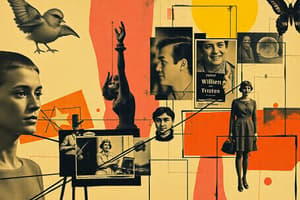Podcast
Questions and Answers
What allows the music teacher to see the music student?
What allows the music teacher to see the music student?
- There is a regular window between them.
- Because the lighting in the room makes the student visible.
- There might be a one-way mirror or transparent surface allowing visibility from one side. (correct)
- The music student is wearing reflective clothing.
Why does the music student see himself and not the teacher?
Why does the music student see himself and not the teacher?
- The teacher is hiding from the student's view.
- The room is too dark for the student to see anything else.
- The surface they are looking through might be reflective on the student's side. (correct)
- The teacher is invisible.
What is necessary in the scale model to properly investigate a mirror-window?
What is necessary in the scale model to properly investigate a mirror-window?
- An accurate representation of reflective properties. (correct)
- A mechanism to control student visibility.
- A detailed outline of the teacher's position.
- A simulation of ambient light conditions.
Which of the following statements is false regarding the visibility issues in the room?
Which of the following statements is false regarding the visibility issues in the room?
What might be a potential misconception about the visibility situation between the teacher and student?
What might be a potential misconception about the visibility situation between the teacher and student?
What is the primary function of a periscope in a science laboratory?
What is the primary function of a periscope in a science laboratory?
What observation might students make when using a flashlight and transparent glass?
What observation might students make when using a flashlight and transparent glass?
In the hall of mirrors at the amusement park, what effect do different shapes of mirrors have on reflections?
In the hall of mirrors at the amusement park, what effect do different shapes of mirrors have on reflections?
How does the magician create the illusion of making an object disappear?
How does the magician create the illusion of making an object disappear?
What contributes to the light patterns observed on the floor when looking through partially closed blinds?
What contributes to the light patterns observed on the floor when looking through partially closed blinds?
What is a key advantage of using the box model in exploring the mirror-window phenomenon?
What is a key advantage of using the box model in exploring the mirror-window phenomenon?
Which of the following elements is crucial to include in the scale model when investigating the mirror-window phenomenon?
Which of the following elements is crucial to include in the scale model when investigating the mirror-window phenomenon?
What does the term 'mirror-window phenomenon' primarily refer to?
What does the term 'mirror-window phenomenon' primarily refer to?
How does maintaining respectful classroom norms enhance science discussions?
How does maintaining respectful classroom norms enhance science discussions?
What is the primary goal of consensus discussions regarding mirror-window diagrams?
What is the primary goal of consensus discussions regarding mirror-window diagrams?
What might be a limitation when using the box model to examine the mirror-window phenomenon?
What might be a limitation when using the box model to examine the mirror-window phenomenon?
Why is it vital to address visibility in classroom dynamics?
Why is it vital to address visibility in classroom dynamics?
What is a significant outcome expected from using evidence-supported responses in assessments?
What is a significant outcome expected from using evidence-supported responses in assessments?
What is the primary purpose of using diagrams in scientific explanations?
What is the primary purpose of using diagrams in scientific explanations?
Why are 'noticings and wonderings' important in a science classroom?
Why are 'noticings and wonderings' important in a science classroom?
What benefit does comparing diagrams with a partner provide?
What benefit does comparing diagrams with a partner provide?
What is the significance of having classroom norms in a science class?
What is the significance of having classroom norms in a science class?
Why is it crucial to consider the limitations of a model in scientific exploration?
Why is it crucial to consider the limitations of a model in scientific exploration?
What does systems thinking encompass in the context of scientific exploration?
What does systems thinking encompass in the context of scientific exploration?
What is the purpose of using scale models in scientific investigations?
What is the purpose of using scale models in scientific investigations?
Why do you record 'noticings and wonderings' while watching a scientific phenomenon?
Why do you record 'noticings and wonderings' while watching a scientific phenomenon?
Flashcards are hidden until you start studying
Study Notes
Visibility Between Teacher and Student
- A one-way mirror or transparent surface enables the teacher to see the student while remaining unseen by the student.
- Regular windows would allow both parties visibility, which does not align with the scenario described.
- Lighting conditions do not contribute significantly to one-sided visibility; thus, they are not a primary factor.
- Reflective clothing does not play a role in the visibility dynamics between the teacher and student.
Student's Perspective
- The student can see himself due to the reflective nature of the surface they are observing.
- There is no evidence supporting the notion that the teacher is invisible to the student.
- Insufficient room lighting does not explain the singular visibility of the student.
- Claims about the teacher hiding lack a basis in the described setup.
Scale Model Investigation
- The scale model must accurately incorporate the properties of a one-way mirror to study the visibility dynamics.
- Reflection and refraction characteristics should be included to better understand how sight is obstructed or facilitated.
- Ensuring that the model demonstrates how each side of the mirror operates differently is crucial for investigation.
Assessment Opportunities
- Test banks provide additional assessment options for OpenSciEd Middle School lessons.
- Questions are multi-dimensional and editable, allowing customization to suit diverse student needs.
Question Types
-
Multiple Choice Questions:
- Feature 4-5 answer options, with the correct answer listed first.
- Teachers must shuffle answers before distribution.
-
Evidence-supported Response:
- Involves selecting the best response from provided options and supporting it with evidence.
- Scoring guidance assists teachers in evaluating responses.
-
Scenario-based Free Response:
- Presents scenarios with three open-ended questions for students to answer.
- Teachers receive scoring guidance to assess student understanding.
Multiple Choice Questions Highlights
- Explore concepts such as the mirror-window phenomenon and classroom norms.
- Encourage understanding of the purpose of diagrams and the importance of noticings and wonderings in science discussions.
- Assess students’ grasp of systems thinking and the limitations of models in scientific inquiry.
Evidence-supported Response Insights
- Focus on the role of diagrams in comprehending the mirror-window phenomenon.
- Discuss the significance of valuing each student's ideas in classroom discussions.
- Highlight the importance of preparing 'Notice and Wonder' charts for new phenomena.
Scenario-based Free Response Reflections
- Scenarios engage students in practical applications of phenomena involving reflections, light, and perception.
- Examples include:
- Observing a music lesson through a one-way mirror illustrating the mirror-window concept.
- Utilizing a periscope to see over a barrier, emphasizing the functionality of mirrors.
- Experiments with light and transparent surfaces, demonstrating reflections and transparency.
- Experiences in a hall of mirrors prompting inquiry about mirror shapes and reflections.
- Curiosity about a magician’s trick using light and mirrors to create illusions.
- Observing patterns of light and shadow through partially closed blinds, prompting questions about light behavior.
Studying That Suits You
Use AI to generate personalized quizzes and flashcards to suit your learning preferences.




